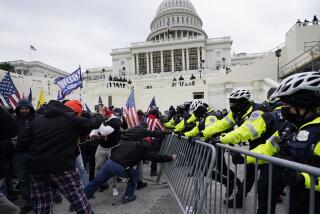What really happened during the wait for Trump to quell the Jan. 6 insurrection
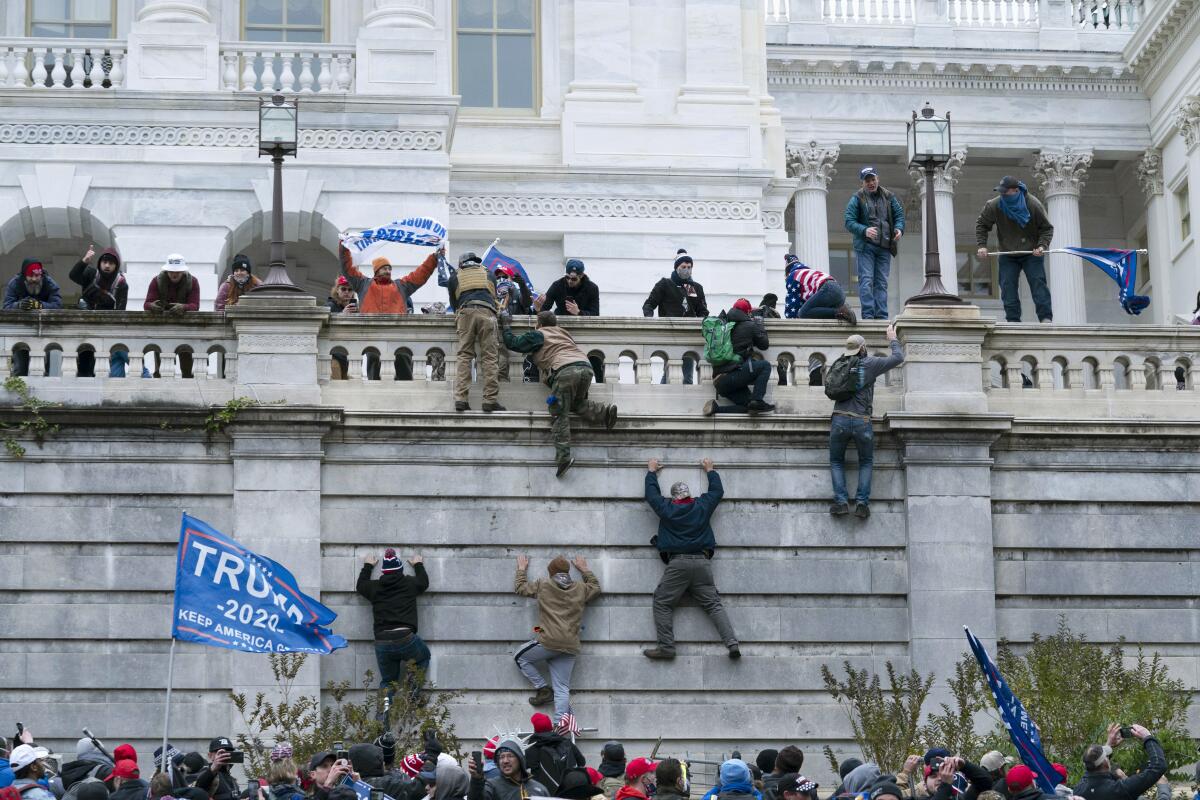
- Share via
WASHINGTON — The House Jan. 6 committee’s prime-time hearing Thursday is billed as a look at what former President Trump did in the 187 minutes between the start of the insurrection and when he urged his supporters to leave the Capitol.
The panel will detail the calls Trump made to lawmakers trying to convince them to further his plan to stay in power even as they were evacuated; the tweets he sent decrying Vice President Mike Pence, who was fleeing the mob; and the time a reportedly gleeful Trump spent watching the riot on television as family and aides begged him to intervene.
But just as telling are the actions the former president did not take in that time.
Public records, congressional testimony and reporting provide a detailed if not definitive timeline of frantic interactions behind the scenes as officials sought to expel a growing crowd of white supremacists, armed militia members and thousands of others who were trying to stop Congress from certifying Joe Biden’s victory based on the false claim that the 2020 election had been stolen.
Evidence shows there were multiple remote meetings from the White House Situation Room; huddles to coordinate the law enforcement response; and emotional phone calls and messages among national security officials, a handful of senior White House aides, and — as they hid in safe rooms at the Capitol — congressional leaders and the vice president.
This is the story of what happened without Trump on Jan. 6.
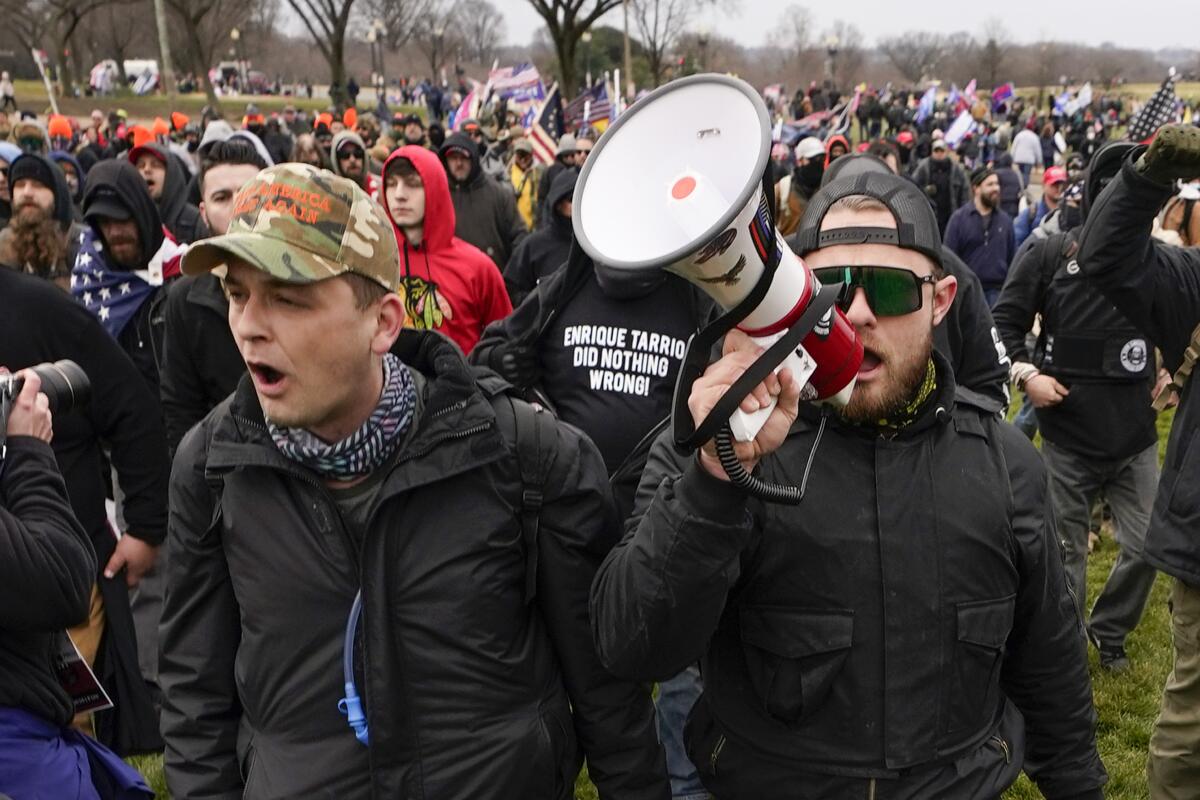
House Speaker Nancy Pelosi (D-San Francisco) had just started the joint session of Congress at 1:05 p.m. when Trump ended his speech at the Ellipse near the White House by encouraging the crowd to go to the Capitol. Some had already broken through the first line of police barriers.
As Trump left the stage, Capitol Police Chief Steven Sund asked the Senate and House sergeants at arms to allow him to call in the District of Columbia National Guard. Sund has said in congressional testimony that the sergeants at arms told him the decision would have to be run by congressional leaders. The approval would not come for over an hour.
As Trump walked to his motorcade and his car made the two-minute drive to the White House, Metropolitan Police Chief Robert Contee updated Washington Mayor Muriel Bowser about the situation at the Capitol. Acting Atty. Gen. Jeffrey Rosen spoke by phone with acting U.S. Atty. for the District of Columbia Michael Sherwin.
Trump arrived at the White House at 1:19 p.m. He went to the Oval office and spoke to his valet at 1:21 p.m., according to the last entries in the Daily Diary, the official log of his movements, until 4 p.m.
Calls and emails flowed among the Pentagon, the Justice Department, Bowser’s office and local law enforcement.
At 1:49 p.m., Metropolitan Police declared a riot at the Capitol. Bowser, who had already asked Army Secretary Ryan D. McCarthy to send in the Guard, called him a second time. Sund called the Secret Service to ask for help, according to emails released through a records request.
Around the same time, according to congressional testimony, Sund called D.C. National Guard Commanding Gen. William Walker to tell him a request from the Capitol Police for assistance was imminent because the security perimeter had been breached at the Capitol.
“Chief Sund, his voice cracking with emotion, indicated that there was a dire emergency on Capitol Hill and requested the immediate assistance of as many Guardsmen as I could muster,” Walker said in congressional testimony.
Walker alerted Army leaders, and Sund activated the Metropolitan Washington Council of Governments Mutual Aid Agreement to formally request assistance from nearby law enforcement agencies.
Rioters first entered the Capitol through windows they had broken at 2:11 p.m., and Pence evacuated the Senate just two minutes later as the chamber went into recess.
A minute later, rioters reached the Capitol’s second floor using a staircase that led them within feet of a Senate entrance. Officer Eugene Goodman drew the rioters away from the unguarded entrance as officers inside rushed to lock the chamber’s doors.
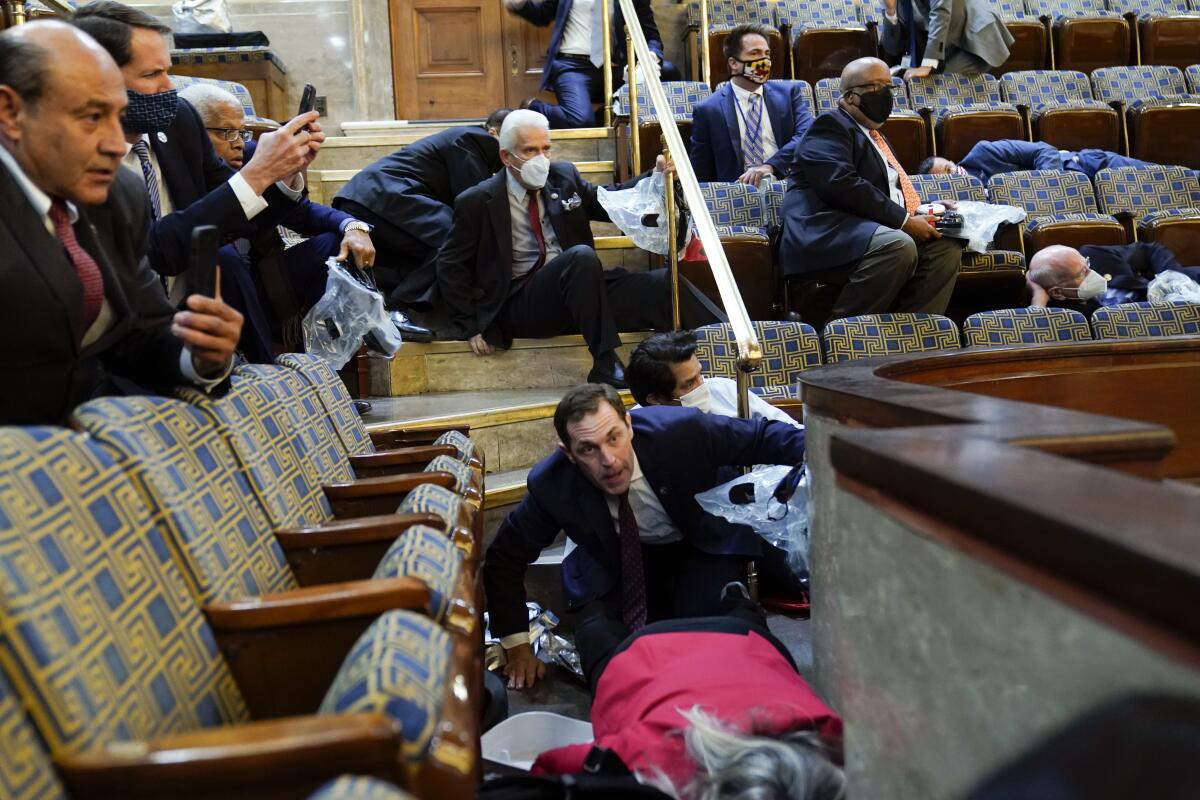
Acting Defense Secretary Christopher Miller spoke at 2:22 p.m. by phone with D.C. officials, Capitol Police and National Guard leaders about Bowser and Sund’s requests for National Guard support.
Sund said in congressional testimony that Lt. Gen. Walter Piatt, the director of Army Staff, told him he didn’t “like the visual of the National Guard standing a line with the Capitol in the background.” Ultimately, Piatt took the request to his superiors.
While that call was taking place, Trump made a public statement for the first time since the violence had begun, tweeting at 2:24 p.m.: “Mike Pence didn’t have the courage to do what should have been done to protect our Country and our Constitution, giving States a chance to certify a corrected set of facts, not the fraudulent or inaccurate ones which they were asked to previously certify. USA demands the truth!”
Acting Deputy Atty. Gen. Richard Donoghue received a call at 2:29 p.m. from the acting chief of the counterterrorism section of the Justice Department’s National Security Division, according to department call logs. The two would speak 10 times over the course of the day.
Meanwhile, Bowser’s office contacted the White House Executive Office of the President, and staff-level conversations began, according to congressional testimony. And Miller, McCarthy and Chairman of the Joint Chiefs of Staff Mark Milley met for the first time to discuss deploying the D.C. National Guard.
“It became clear during that meeting that local and federal law enforcement personnel were insufficient to address the situation and that the Department of Defense would be required to play a much larger role in reestablishing order and maintaining security,” Miller told a congressional committee last year.
At 2:38 p.m., Trump tweeted again: “Please support our Capitol Police and Law Enforcement. They are truly on the side of our Country. Stay peaceful!”
Capitol Police asked the Bureau of Alcohol, Tobacco, Firearms and Explosives to assist with pipe bombs found at the Republican National Committee headquarters as the riot began and at the Democratic National Committee headquarters a short time later. Bowser declared a state of emergency and a citywide curfew starting at 6 p.m.
A U.S. Capitol Police officer fatally shot Trump supporter Ashli Babbitt at 2:44 p.m. as she climbed through a broken window that would give rioters access to the House floor. Ten minutes later, dozens of House members and staffers were escorted from the chamber.
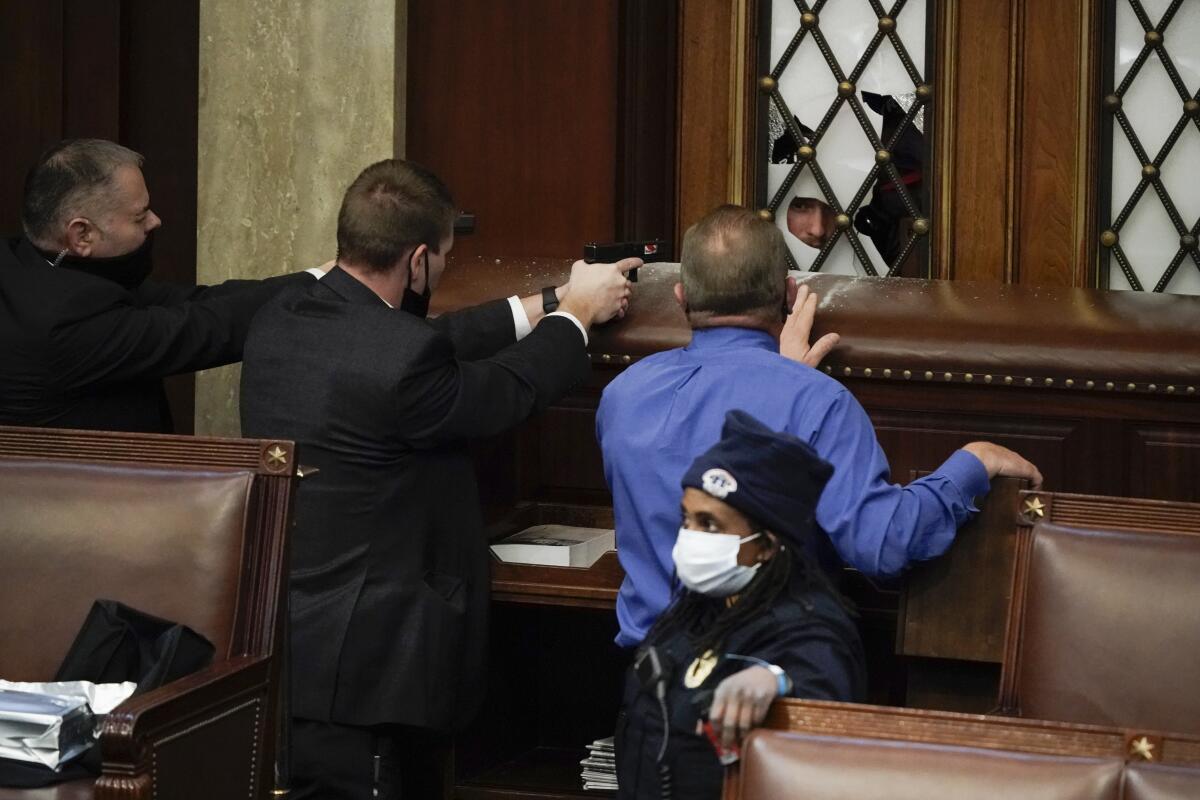
Bowser spoke with White House Chief of Staff Mark Meadows at 2:56 p.m., and White House Counsel Pat Cipollone called Rosen at 2:57 p.m. Cipollone spoke with Rosen or Donoghue 15 times on Jan. 6, according to Justice Department call logs.
Around this time, House Minority Leader Kevin McCarthy (R-Bakersfield) spoke with Trump; he was the only congressional leader to do so that day.
“When McCarthy finally reached the president on January 6 and asked him to publicly and forcefully call off the riot, the president initially repeated the falsehood that it was antifa that had breached the Capitol. McCarthy refuted that and told the president that these were Trump supporters. That’s when, according to McCarthy, the president said: ‘Well, Kevin, I guess these people are more upset about the election than you are,’” Rep. Jaime Herrera Beutler (R-Wash.) later wrote.
Miller placed 1,100 members of the D.C. National Guard on standby at 3:04 p.m. pending his final approval of a plan for how they would be used.
Trump tweeted at 3:13 p.m.: “I am asking for everyone at the U.S. Capitol to remain peaceful. No violence! Remember, WE are the Party of Law & Order — respect the Law and our great men and women in Blue. Thank you!”
Army Secretary McCarthy told Pelosi and Senate Majority Leader Charles E. Schumer (D-N.Y.) at 3:19 p.m. that the full mobilization of the D.C. National Guard had been approved.
Donoghue called the acting administrator of the Drug Enforcement Administration and the acting director of the ATF. At 3:30 p.m. Bowser called Pelosi and House leaders.
Donoghue spoke for 11 minutes to someone who called from a White House line at 3:44 p.m. It was the first White House number to appear in the Justice Department logs that day since the riot began. The department redacted names and numbers for several calls on Jan. 6, so there may have been earlier calls from the White House.
At the same time, congressional leaders implored Pentagon officials in a call to force Trump to act.
“Tell POTUS to tweet everyone should leave,” Schumer said, according to the Associated Press.
National Guard officials began coordinating with governors in surrounding states to deploy their Guard troops. Miller, the acting Defense secretary, traveled to Metropolitan Police headquarters to oversee preparations for how the Guard would be used.
Pelosi and Schumer released a joint statement at 3:55 p.m., imploring Trump to ask his supporters to withdraw. “We are calling on President Trump to demand that all protesters leave the U.S. Capitol and Capitol grounds immediately,” their statement said.
Deputy FBI Director David Bowdich urged Donoghue by email at 4:01 p.m. to call Army Secretary McCarthy because the Guard was still not helping defend the Capitol. “They are all parked,” stated the email, released through the Freedom of Information Act.
Entries in Trump’s Daily Diary resumed at 4 p.m., showing that from that point onward, he made no phone calls to check in with Pence, national security officials or congressional leaders; did not go to the Situation Room; and had no briefings from National Security Council staff.
At 4:03 p.m., Trump recorded a video in the White House Rose Garden urging supporters to go home. A minute after Trump reentered the Oval Office at 4:07 p.m., Pence called Miller from the underground garage to which he’d been evacuated.
Pence said the Capitol was not secure, and asked military leaders for a deadline for securing the building, according to an internal Defense Department timeline reported on by the Associated Press. Pence demanded that the Capitol be cleared.
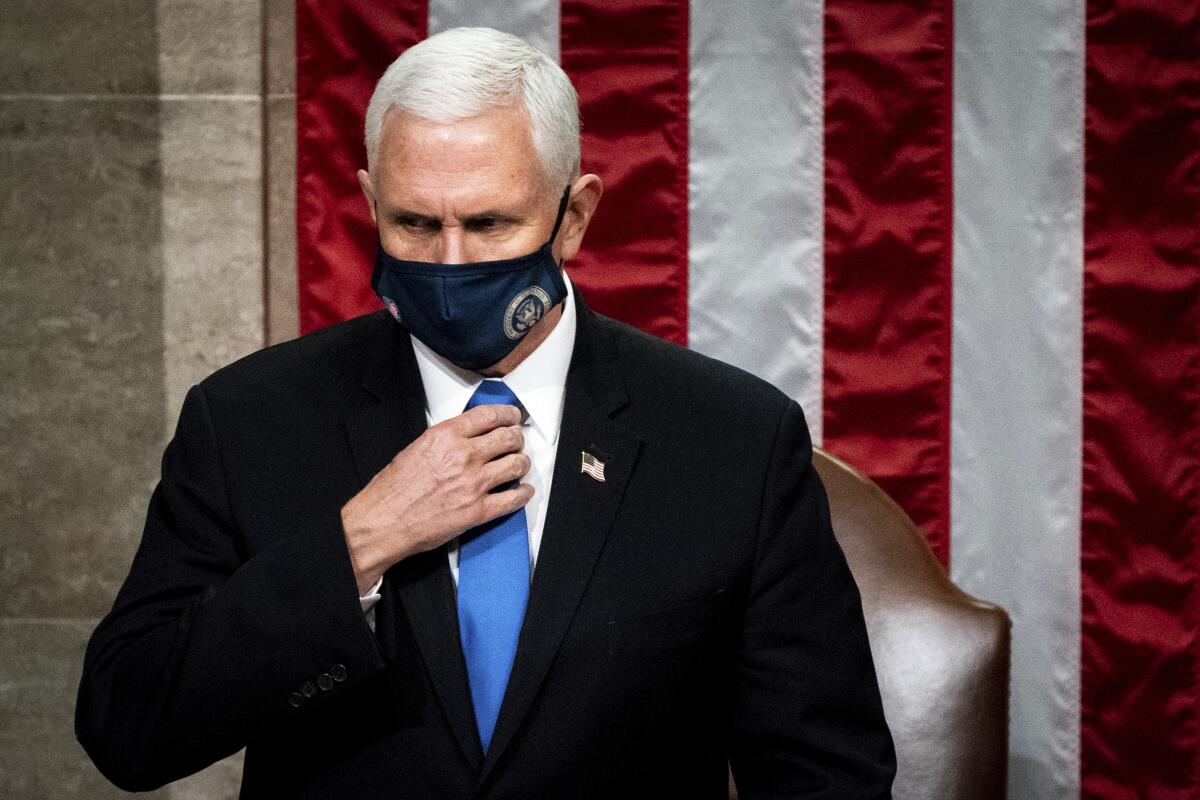
At 4:17 p.m., Trump released a video on Twitter addressing his supporters.
“I know your pain. I know you’re hurt,” Trump said, and repeated his false claim that Biden’s election win was fraudulent.
“We have to have peace. We have to have law and order,” he continued. “We have to respect our great people in law and order. We don’t want anybody hurt.... So go home. We love you; you’re very special. You’ve seen what happens; you see the way others are treated that are so bad and so evil. I know how you feel, but go home and go home in peace.”
Trump’s name was noticeably absent from a news release issued by national security officials at 4:43 p.m. to inform the public of the full deployment of the D.C. National Guard.
“[Joint Chiefs] Chairman Milley and I just spoke separately with the Vice President and with Speaker Pelosi, [Senate Republican leader Mitch] McConnell, Senator Schumer and [House Majority Leader Steny H.] Hoyer about the situation at the U.S. Capitol,” McCarthy, the Army secretary, said in the statement.
Milley later told the Jan. 6 committee that Meadows appeared to be covering for the president’s inaction, and wanted the Pentagon to give the impression that Trump was in charge.
“He said we have to kill the narrative that the vice president is making all of the decisions,” Milley told the panel in a deposition.
The National Guard arrived at the Capitol by 5:40 p.m., nearly four hours after the first request for their help. At 5:56 p.m., a call began from the Situation Room to update national security leaders. U.S. Capitol Police and police dogs searched each room inside the Capitol.
At 6:01 p.m., Trump sent another tweet, again falsely claiming there had been fraud in the election, and that it was stolen from him.
“These are the things and events that happen when a sacred landslide election victory is so unceremoniously & viciously stripped away from great patriots who have been badly & unfairly treated for so long,” Trump tweeted. “Go home with love & in peace. Remember this day forever!”
Police Chief Sund briefed congressional leaders by phone at 6:25 p.m., telling them that police and the National Guard had secured the Capitol and its perimeter and that election certification could resume. Trump went to the White House residence at 6:27 p.m., according to the Daily Diary.
A second call to national security leaders was made from the Situation Room at 7 p.m., according to notes Donoghue took that were released through a Freedom of Information Act request.
“I never spoke to the president that day. He was not on any calls that I was on,” Donoghue later told the Jan. 6 panel in a deposition.
Rosen received an email at 7:10 p.m. from the Justice Department’s National Security Division: “Order is being restored inside the Capitol Building. Senate and House members are sheltering in place until they can be evacuated.”
Trump did not take part in a 7:20 p.m. call with Pence, Pelosi, Schumer, House GOP leader McCarthy and McConnell (R-Ky.), who were briefed by Rosen, Donoghue and Miller.
“We briefed them all on this and told them that we cleared their chambers and they could go back in and restart their sessions,” Justice Department spokesman Marc Raimondi said in an email released through a records request.
Trump took or made several phone calls that evening, according to the Daily Diary. He spoke with Cipollone and communications director Dan Scavino; with conservative lawyers Kurt Olsen, Mark Martin and Cleta Mitchell, who had informally advised him on how to overturn the election, as well as his attorney Rudolph W. Giuliani; and with political strategist Stephen K. Bannon and campaign manager Jason Miller.
Trump’s last recorded action of the day was an 18-minute call beginning at 11:23 p.m. with John McEntee, director of the White House Presidential Personnel Office. Several Cabinet members and prominent staff members had resigned that day, including deputy national security advisor Matthew Pottinger, who is expected to testify at Thursday’s hearing.
No major national security official has said under oath that they spoke with Trump on Jan. 6.
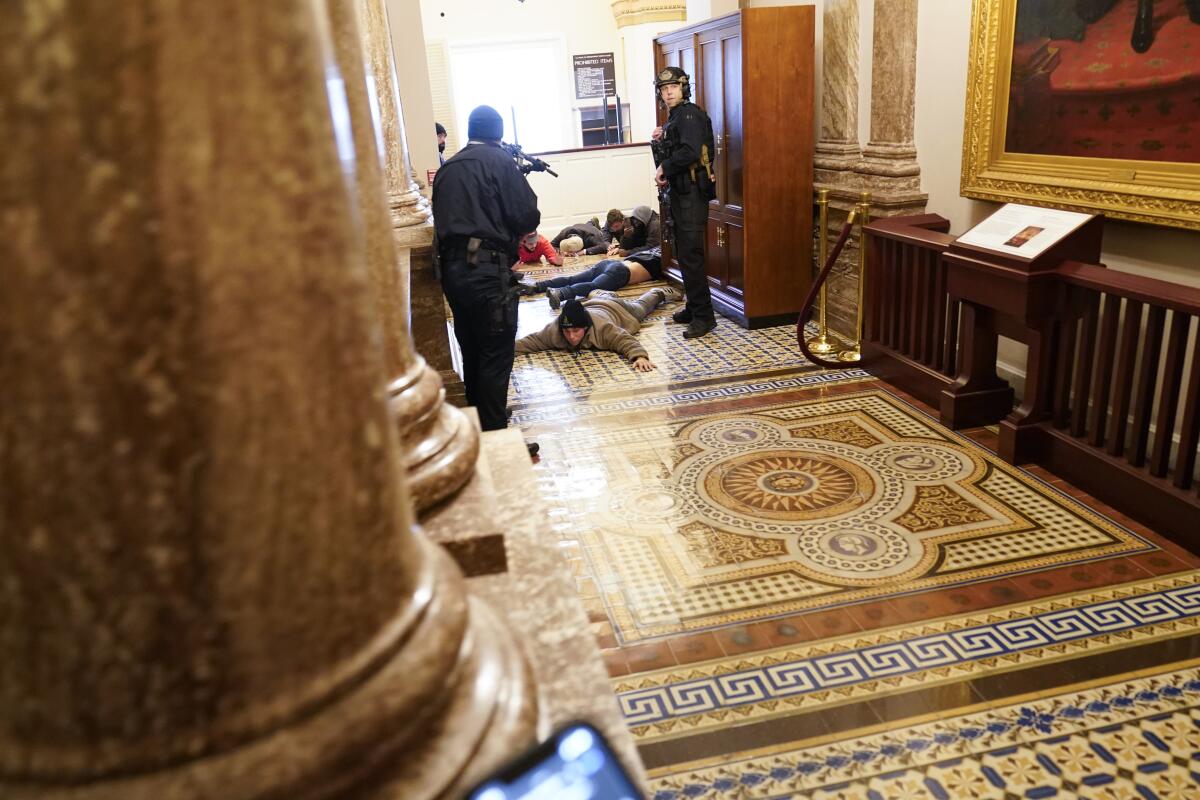
Miller, the Defense secretary, told Congress in May 2021 he had spoken with Trump twice in the days before Jan. 6, but hadn’t spoken with him the day of the riot. “I had all the authority I needed and knew what had to happen,” he said. Unnamed Pentagon officials told Vanity Fair on condition of anonymity that Miller had tried repeatedly to speak with Trump on the phone that day, but failed to reach him.
Rosen told the Jan. 6 committee in a deposition he did not speak with Trump between Jan. 3 and Jan. 19, but he had spoken with Meadows, Cipollone and national security advisor Robert O’Brien on Jan. 6.
“They were very much in the same posture we were: Let’s get as much help to the Capitol as fast as possible. So I think that there was at least the hope that somebody in the White House could talk to the president,” Rosen said.
Committee Vice Chair Liz Cheney (R-Wyo.) pressed the point during Rosen’s deposition, asking him: “How did you think about the fact that you had talked to everybody up to the vice president, but not the president?”
Rosen stumbled as he tried to answer.
“I’m really not — not really even sure how to respond to that, because we got so focused during the day on what we have to do and what can we do and trying to be in a posture of being part of the solution, trying to be helpful,” Rosen said.
“Obviously, the situation was terrible, but once this breach of the Capitol occurred there was this tremendous urgency and just ongoing all day long,” he continued, “You know — what’s happening, what can we do, what else do we know and what do we hear from [the Homeland Security Department], what do we know — that it just gets caught up in the moment of, ‘Let’s do our job,’ you know — ‘We’ll do our job. And let’s hope everybody is doing what they’re supposed to do.’ And that’s how I remember it.”
For the record:
8:37 a.m. July 22, 2022An earlier version of this article said that Trump released a second video condemning the Capitol rioters at 7:10 p.m. on Jan. 6, 2021. The White House released the video at 7:10 p.m. on Jan. 7, 2021.
On Jan. 7 at 7:10 p.m., the White House finally released a second video from Trump, this time condemning the violence of the day before and acknowledging a new administration would take office Jan. 20.
“Like all Americans, I am outraged by the violence, lawlessness and mayhem. I immediately deployed the National Guard and federal law enforcement to secure the building and expel the intruders,” the outgoing president said in the three-minute video.
More to Read
Get the L.A. Times Politics newsletter
Deeply reported insights into legislation, politics and policy from Sacramento, Washington and beyond. In your inbox three times per week.
You may occasionally receive promotional content from the Los Angeles Times.


